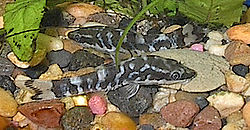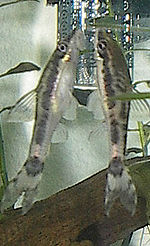- Otocinclus
-
Otocinclus 
Zebra Oto - Otocinclus cocama Scientific classification Kingdom: Animalia Phylum: Chordata Class: Actinopterygii Order: Siluriformes Family: Loricariidae Subfamily: Hypoptopomatinae Tribe: Hypoptopomatini Genus: Otocinclus
Cope, 1871Type species Otocinclus vestitus
Cope, 1871Species Over a dozen, see text.
Synonyms - Lampiella
Isbrücker, 2001 - Macrotocinclus
Isbrücker & Seidel, 2001
Otocinclus is a genus of catfish (order Siluriformes) of the family Loricariidae commonly called "dwarf suckers" or "otos". Otocinclus originate from tropical, freshwater rivers in South America.
Contents
Taxonomy
Edward Drinker Cope described this genus in 1871. The type species is O. vestitus. Otocinclus is pronounced "ahto-SINK-luss". The name is derived from the Greek word oto, ear, and the Latin word cinclus, meaning a latticework; an allusion to the holes in the head in the region of the ear.[1]
Otocinclus is the most basal genus of the tribe Hypoptopomatini of the subfamily Hypoptopomatinae. However, phylogenetic relationships are currently under study and this genus may eventually be relocated.[2] Its monophyly is supported by seven derived features. There are currently about 16 species.[2] O cocama, O. huaorani, O. bororo, O. mariae, and O. mura, and O. batmani form a monophyletic group within this genus.[2] A monophyletic group is also formed by O. flexilis, O. affinis, O. xakriaba, and O. mimulus, which all share mimicry as a synapomorphy.[3]
Distribution
Otocinclus are widely distributed east of the Andes of South America, throughout the lowlands from northern Venezuela to northern Argentina, but is generally absent from the Amazon and the Orinoco lowlands.[3]
Description
Otocinclus, like other loricariids, are characterized by rows of armour plating covering the body, as well as theunderslung suckermouth. They are generally small in size; Otocinclus tapirape is the smallest of the species (2.4 cm), while Otocinclus flexilis is the biggest (5.5 cm). These fish do not exceed 50 millimetres (2.0 in) SL.[4]
Otocinclus spp. have adaptations that allow these fish to breathe air. A duct forms at the junction between the esophagus and the stomach and expands into an enlarged, ring-like diverticulum, diagnostic of this genus, which allows air-breathing of these fishes.[5]
Ecology
Otocinclus species are diurnal, and generally are found in small streams or along the margins of larger rivers, clinging to substrates using the mouth as a sucker, and feeding from algae or aufwuchs on roots, stones, macrophytes, and broad-leaved grasses.[3] They inhabit well-oxygenated, moderate- to slow-flowing environments, often near river banks.[4] They are found near the surface of the water, but are often associated with vegetation or other structures.[2] They lay adhesive eggs and do not guard them; this is in contrast to many other loricariids where the male builds a nest and guards the eggs.[6] These fish live in shoals or schools.[3]
Otocinclus are able to breathe air. Prior to surfacing, they will release air through their gills and mouth. Upon returning to the bottom, the fish do not need to pump their buccal cavities, indicating they are absorbing oxygen from the swallowed air.[5]
O. mimulus, O. flexilis, O. affinis, and O. xakriaba are considered to be Batesian mimics of certain Corydoras species (C. diphyes, C. paleatus, C. nattereri, and C. garbei, respectively). These Corydoras species have bony plates of armor and strong spines as defenses, making them less palatable; by mimicking these species in size and coloration, Otocinclus spp. avoid predation.[3]
In the aquarium
Otocinclus spp. are popular aquarium fish. They are often purchased as algae eaters, and are more suitable for the job in smaller aquaria than many of the larger loricariid relatives, such as plecostomus. Water quality should be kept clean for these fish. As otos like company, they should be kept in groups of three or more individuals, unlike most other plecos.[6] They are generally delicate fish, and only thrive in heavily planted aquariums. If not enough algae are present in the aquarium, their diets can be supplemented with algae wafers, blanched zucchini, and other plant foods.
Species
As of January 2007, the genus consists of 18 species:[7]
- O. affinis, Steindachner, 1877 — "Golden oto"
- O. batmani, Lehmann, 2006[2]
- O. bororo, Schaefer, 1997
- O. caxarari, Schaefer, 1997
- O. cocama, Reis, 2004 — "zebra oto"[8]
- O. flexilis, Cope, 1894 — "peppered oto"
- O. gibbosus, Miranda Ribeiro, 1908
- O. hasemani, Steindachner, 1915
- O. hoppei, Miranda Ribeiro, 1939
- O. huaorani, Schaefer, 1997
- O. macrospilus, Eigenmann and Allen, 1942
- O. mariae, Fowler, 1940
- O. mimulus, Axenrot and Kullander, 2003[3]
- O. mura, Schaefer, 1997
- O. tapirape, Britto & Moreira, 2002[4]
- O. vestitus, Cope, 1872
- O. vittatus, Regan, 1904
- O. xakriaba, Schaefer, 1997
External links
- Otocinclus.com – Home of the dwarf suckermouth catfishes
- Robyn's Oto Page
References
- ^ Froese, Rainer, and Daniel Pauly, eds. (2007). Species of Otocinclus in FishBase. Apr 2007 version.
- ^ a b c d e Lehmann, Pablo A. (2006). "Otocinclus batmani, a new species of hypoptopomatine catfish (Siluriformes: Loricariidae) from Colombia and Peru" (PDF). Neotropical Ichthyology 4 (4): 379–383. doi:10.1590/S1679-62252006000400001. http://www.ufrgs.br/ni/vol4num4%5CNI4(4)-379-383lr.pdf.
- ^ a b c d e f Axenrot, Thomas E.; Kullander, Sven O. (October 2003). "Corydoras diphyes (Siluriformes: Callichthyidae) and Otocinclus mimulus (Siluriformes: Loricariidae), two new species of catfishes from Paraguay, a case of mimetic association" (PDF). Ichthyol. Explor. Freshwaters 14 (3): 249–272. http://www.ecology.su.se/pdfs/axenrot/fish.pdf. Retrieved 2009-06-23.
- ^ a b c Britto, Marcelo R.; Moreira, Cristiano R. (2002). Schaefer, S. A.. ed. "Otocinclus tapirape: A New Hypoptopomatine Catfish from Central Brazil (Siluriformes: Loricariidae)" (PDF). Copeia 2002 (4): 1063–1069. doi:10.1643/0045-8511(2002)002[1063:OTANHC]2.0.CO;2. http://www.ib.usp.br/~cmoreira/publications/otocinclus.pdf.
- ^ a b "Modifications of the Digestive Tract for Holding Air in Loricariid and Scoloplacid Catfishes" (PDF). Copeia (3): 663–675. 1998. http://www.auburn.edu/academic/science_math/res_area/loricariid/fish_key/Air.pdf. Retrieved 2009-06-23.
- ^ a b Fenner, Robert. "The Ideal Algae Eater? The Littlest South American Suckermouth Catfishes, Genus Otocinclus". http://www.wetwebmedia.com/FWSubWebIndex/otocinclusart.htm. Retrieved 2007-05-04.
- ^ "Otocinclus". Integrated Taxonomic Information System. http://www.itis.gov/servlet/SingleRpt/SingleRpt?search_topic=TSN&search_value=164354. Retrieved Apr 27, 2007.
- ^ Reis, Roberto E. (2004). "Otocinclus cocama, a new uniquely colored loricariid catfish from Peru (Teleostei: Siluriformes), with comments on the impact of taxonomic revisions to the discovery of new taxa" (PDF). Neotropical Ichthyology 2 (3): 109–116. http://www.ufrgs.br/ni/vol2num3%5CArtigo01_Reislowr.pdf.
Categories:- Hypoptopomatini
- Fish of South America
- Lampiella
Wikimedia Foundation. 2010.


